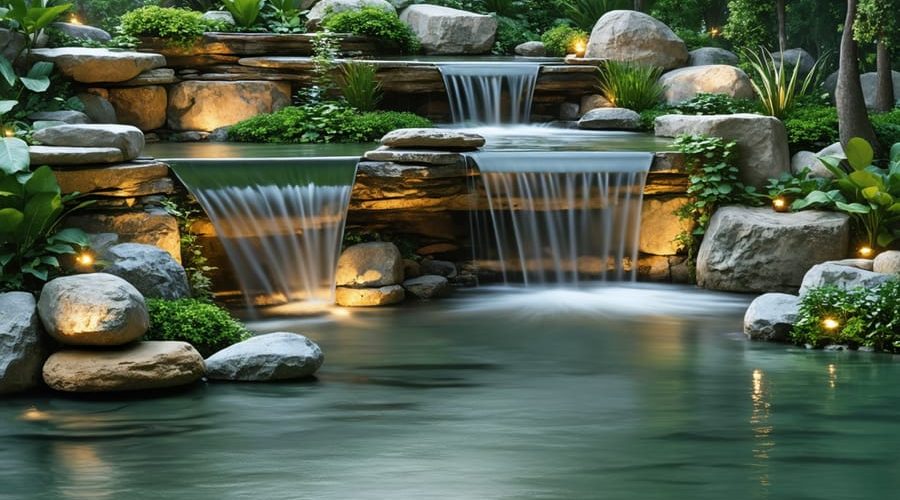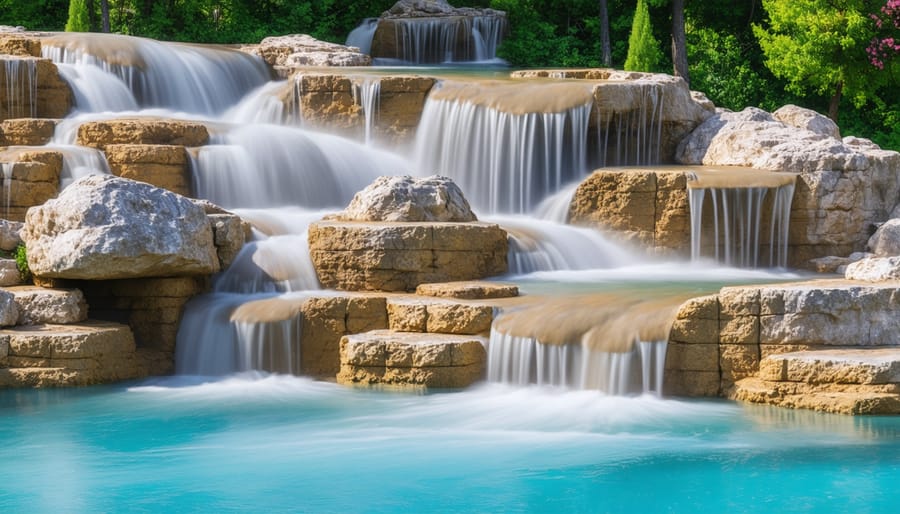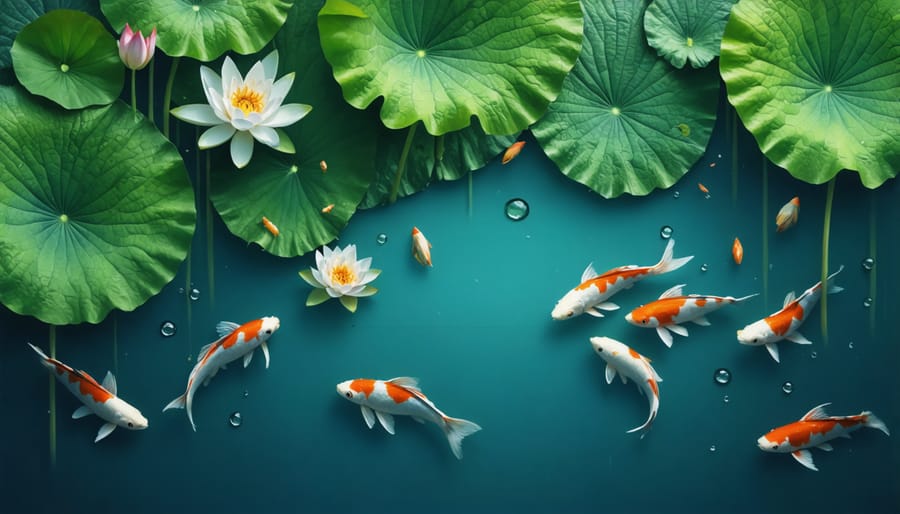
Transform Your Pond into Living Art: Essential Sculptural Elements That Create Magic
Sculpture transcends mere artistic expression – it’s a powerful dialogue between form, space, and material that has shaped human culture for millennia. When building a natural pond, understanding sculptural elements transforms ordinary water features into captivating focal points that engage viewers from every angle. Whether working with stone, metal, or organic materials, successful sculptural design balances five key elements: mass, space, line, texture, and movement. These fundamental components work together to create visual harmony while maintaining the natural authenticity that DIY pond enthusiasts seek.
Modern sculptural elements in water features don’t require formal art training – they emerge from thoughtful placement of rocks, strategic use of negative space, and understanding how water interacts with different materials. The key lies in observing nature’s own sculptural patterns and replicating them in ways that feel both intentional and organic. By mastering these basic principles, even novice pond builders can create professional-looking features that capture attention and enhance their outdoor spaces.
This practical approach to sculptural elements helps bridge the gap between artistic vision and technical execution, making sophisticated design accessible to everyday gardeners and pond enthusiasts.
Natural Stone Elements: The Foundation of Pond Sculpture
Creating Dynamic Rock Arrangements
Creating dynamic rock arrangements is all about finding the perfect balance between stability and visual interest. Start by selecting rocks of varying sizes and shapes, which will help create a more natural-looking composition. Always place your largest stones first, as these will serve as anchor points for your arrangement.
When positioning rocks, consider the rule of thirds – imagine your space divided into a 3×3 grid and place key stones at the intersection points. This creates a more pleasing visual flow. Lean slightly larger rocks at natural angles, avoiding perfectly vertical or horizontal placements that can look artificial.
Layer your rocks by starting with a solid base of larger, flatter stones. As you build upward, incorporate smaller stones to create natural-looking crevices and gaps. These spaces are perfect for adding plants later, which will help soften the overall appearance.
Try to create a sense of movement in your arrangement by positioning stones so they appear to flow in one direction. This is especially effective in water features, where rocks can guide the eye along the water’s path. Remember to leave some spaces between rocks – these gaps create shadows and depth that make your arrangement more visually interesting.
For a natural look, bury the bottom third of larger rocks and cluster smaller ones around their base. This mimics how rocks would appear in nature and ensures your arrangement looks grounded rather than simply placed on the surface.
Waterfalls and Cascades as Living Sculptures
Water features can transform from simple cascades into mesmerizing living sculptures that capture both movement and light. When designing a water feature, consider how falling water creates different effects: a sheet of water can form a transparent curtain, while separated streams produce musical sounds and catching light. The key is to experiment with different heights, surfaces, and flow rates.
Natural stone provides an excellent foundation for water sculptures. Rough-textured rocks create dynamic, splashing effects, while polished surfaces allow water to glide smoothly. Try incorporating multiple levels and irregular edges to create interesting water patterns and soothing sounds. LED lighting can enhance these effects after dark, turning your water feature into an evening showpiece.
For a contemporary look, consider using metal or glass elements. Copper develops a beautiful patina over time, while stainless steel maintains its sleek appearance. Glass panels can create stunning water walls where the liquid seems to float in mid-air. These materials can be combined with natural elements for a balanced design.
Remember that water movement should feel natural and purposeful. Start with a small prototype to test water flow before committing to a larger installation. Consider seasonal changes too – your water sculpture should look beautiful even when switched off during winter months. Regular maintenance keeps these living sculptures performing at their best, ensuring your artistic vision remains clear and vibrant throughout the years.

Architectural Elements That Define Space
Bridges and Walkways as Artistic Statements
Bridges and walkways in water features aren’t just functional elements – they’re opportunities to create stunning artistic statements that transform your pond into a captivating landscape. A well-designed bridge can serve as both a practical crossing point and a focal point that draws the eye and invites exploration.
Consider incorporating natural materials that complement your existing landscape. Wooden bridges with gentle arches create a classic, timeless look while adding warm, organic textures. For a more contemporary feel, sleek metal or glass designs can make bold architectural statements. Even simple stepping stones, when thoughtfully arranged, can create an engaging path that seems to float above the water.
Lighting plays a crucial role in enhancing these features. Strategic placement of underwater or pathway lights can create magical reflections on the water’s surface at night, turning your bridge into an enchanting centerpiece. Consider installing LED strips along handrails or beneath the walkway for a subtle glow that guides visitors while creating atmosphere.
The materials you choose should not only look beautiful but also withstand outdoor conditions. Cedar and redwood naturally resist decay, making them excellent choices for wooden structures. If using metal, opt for powder-coated or marine-grade materials to prevent rust and maintain their appearance over time.
Remember to integrate your bridge or walkway with surrounding plantings. Trailing plants cascading near the edges or ornamental grasses swaying alongside can soften hard lines and create a more natural transition between water and land. This thoughtful combination of function and aesthetics transforms necessary pathways into artistic elements that enhance your entire water feature.
Lighting as Sculptural Enhancement
Lighting can transform a simple sculpture into a mesmerizing focal point, especially in water features where the interplay of light and water creates enchanting effects. By implementing strategic underwater lighting techniques, you can highlight specific elements of your sculpture while creating depth and drama in your pond or water garden.
Consider placing lights at different angles to create interesting shadows and highlights. Uplighting from beneath the water’s surface can make your sculpture appear to float mysteriously, while spotlighting from above can emphasize texture and form. For the best results, experiment with different positions during nighttime to find the perfect placement that brings out your sculpture’s unique characteristics.
Color temperature plays a crucial role in lighting design. Warm white lights (2700-3000K) create a cozy, inviting atmosphere, while cool white lights (5000-6500K) can make metal sculptures appear more dramatic and modern. For natural stone sculptures, stick to warmer tones that complement the material’s organic qualities.
Remember to consider seasonal changes when planning your lighting setup. As foliage grows and water levels fluctuate, you may need to adjust light positions to maintain the desired effect. Installing adjustable fixtures gives you the flexibility to modify your lighting scheme throughout the year.
Don’t overlook the importance of layered lighting. Combining different types of lights – submersible, floating, and accent lights – creates depth and visual interest while ensuring your sculpture remains the star of the show, even after dark.

Living Sculptural Elements
Aquatic Plants as Natural Sculptures
Water gardens offer a unique opportunity to create living sculptures that change and evolve with the seasons. When choosing aquatic plants, think of yourself as both a gardener and an artist, considering how each plant’s form, texture, and movement can contribute to your overall design.
Tall, architectural plants like papyrus and rush create striking vertical elements that draw the eye upward, much like classical columns. These can serve as natural focal points or frame other elements in your water feature. Lower-growing floating plants like water lilies add horizontal planes, creating a sense of depth and perspective while offering beautiful geometric patterns on the water’s surface.
Consider the natural growth habits of different species to create dynamic compositions. Layer plants of varying heights, with taller specimens at the back or center and shorter ones in front. This creates a natural theater effect, where each plant can be fully appreciated. Combine different leaf shapes and textures – the sword-like leaves of iris alongside the round pads of water lilies, or the feathery foliage of hornwort contrasting with the broad leaves of lotus.
Movement adds another dimension to your living sculpture. Ornamental grasses that sway in the breeze create kinetic elements, while surface plants drift and dance on the water. The reflection of these plants in the water doubles their visual impact, creating mirror images that enhance the overall sculptural effect.
Remember that these natural sculptures change throughout the growing season. Spring brings fresh green shoots, summer showcases dramatic blooms, and fall offers rich colors and seed heads. Even in winter, many aquatic plants retain interesting structural elements that can be enhanced by frost or snow, turning your pond into a year-round gallery of natural art.

Fish Movement and Color as Living Art
When it comes to creating living art in your water feature, fish serve as dynamic sculptural elements that bring movement, color, and life to your pond. Selecting koi fish and other ornamental species isn’t just about adding inhabitants – it’s about choosing living brushstrokes that paint your aquatic canvas throughout the seasons.
Consider how different fish species move through the water. Koi tend to glide gracefully, creating gentle ripples that catch the light, while smaller fish like golden orfe dart playfully in schools, adding energetic motion to your composition. This natural choreography adds a kinetic dimension that static sculptures simply can’t achieve.
Color plays a crucial role in this living artwork. Mix fish varieties to create a balanced palette – combine the deep oranges and whites of koi with the metallic flash of golden tench, or the subtle shadows of ghost koi. As fish move between sun and shade, their scales catch the light differently, creating an ever-changing display that responds to natural lighting conditions.
Fish behavior also contributes to the sculptural experience. Some species prefer the surface, others the middle depths, and some stick to the bottom, naturally creating layers of interest throughout your pond. During feeding times, they create dynamic patterns as they swim upward, offering an interactive element to your water feature that engages viewers.
Remember that fish aren’t just beautiful – they’re living creatures that need proper care. Their health directly affects your pond’s artistic impact. Well-maintained fish display brighter colors and more active swimming patterns, enhancing the overall visual appeal of your water feature. Consider seasonal changes too, as fish behavior and visibility vary throughout the year, offering different artistic experiences as the seasons change.
As we’ve explored throughout this article, sculptural elements can transform an ordinary pond into a captivating water feature that tells a story and creates lasting impressions. Whether you’re drawn to the timeless appeal of classical statuary, the zen-like qualities of natural stone arrangements, or the playful charm of contemporary sculptures, there’s no limit to what you can achieve in your pond design.
Remember that successful sculpture integration isn’t just about placing decorative elements – it’s about creating harmony between water, light, and form. Start small with a single focal point, like a graceful fountain or strategically placed boulder, and observe how it influences the overall atmosphere of your water garden. As your confidence grows, experiment with different combinations and arrangements.
Don’t be afraid to let your personality shine through your choices. Your pond is a personal sanctuary, and the sculptural elements you choose should reflect your taste and style. Consider how different materials interact with water, how seasonal changes affect their appearance, and how they contribute to the overall ecosystem of your pond.
Keep in mind the practical aspects we’ve discussed: proper scale, strategic placement, and maintenance requirements. These considerations will ensure your sculptural elements enhance rather than overwhelm your pond space. Regular maintenance and occasional repositioning can keep your design fresh and engaging throughout the years.
For those just starting, visit local garden centers, art galleries, or water garden shows for inspiration. Take photos, sketch ideas, and imagine how different elements might work in your space. Remember that creating an artistically pleasing pond is a journey – one that evolves with your vision and experience.
Now it’s your turn to bring these concepts to life. Whether you’re planning a complete pond makeover or looking to add that perfect finishing touch, the principles and ideas we’ve shared will help guide you toward creating a truly memorable water feature that you’ll enjoy for years to come.
